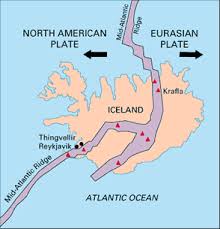Plate Margins
- Created by: Courtney001
- Created on: 20-11-17 11:11
Constructive/Divergent-Oceanic/Oceanic
Two Oceanic plate move away from each other in the Continental Crust and a new crust is created. Because of this Ocean Ridges are produced. The space between the two plates fills with Basaltic lava travelling upwards from the sea bed thus creating Volcanoes.
An Example of a Ocean Ridge is the Mid-Atlantci Ridge Located in Iceand.his is an example of the North American plate and Eurasian Plates moving apart from each other creating the Mid Atlantic Ridge.Has up to a total length of 60,000km and some parts rise 3,000m above the ocean floor.The ridge has an average spreading rate of about 2.5 centimetres per year. Volcanic action occurs here-it's minor but very frequent which is down to pressure.

Constructive/Divergent-Continental/Continental
Two plates moving apart quite slowly. When the plates move apart brittle parts of the crust crumble and drop between parallel faults helping to form rift valleys- witht the bits of crust faling doen it blocks anything from coming up through the valley. Eventually magma will force its way its way ot the surface forming volcanoes- mostly active ones.An Example of this is the East African Rift Valley. The EAR is 4,000km long (from Mozambique to the Red Sea) It is 50km wide. Earthquakes will also occur here.
Destructive/Convergent-Oceanic/Continental
These two plates move underneath each other to where the crust is destroyed. With these plates subduction occurs- More dense plates slude under (oceanic plate). The deeper the oceanic plate goes the hotter the surroundings become . The heat generated rom friction begins to melt the oceanicplate into magma and the magma begins to rise and reach the surface to form volcanoes. A line of volcanic Islands can occur thus creating a Islan Arc.
An Example of this is the Peru Chile Trench.This is located in the eastern Pacific Ocean, about 100 miles off the coast of Peru and Chile. It reaches a maximum depth of 26,460 feet below sea level. It covers an expanse of some 228,000 square miles (590,000 square km).
Destructive/Convergent-Oceanic/Oceanic
The less dense plates slide under the more dense plate creating a subduction Zone called a Trench. This forms both an Island Arc and Trenches. Magma rises to eat the the plate above and then the lava breaks through to the surface where actve volcanoes form.The Basaltic lava flows slowly and forms large but flat volcanoes.
An Example of this is The Marianas Islands, Phillipines.The Mariana Islands are a crescent-shaped arch made up of of fifteen-mostly dormant- volcanic mountains. They lie south-southeast of Japan, west-southwest of Hawaii, north of New Guinea and east of the Philippines.

Destructive/Convergent-Continental/Continental
As these two plate have a similar density it means that Subduction won't occur. Isntead of this the two plates will collide with each other. The edges and sediments in between the plates will be pushed upwards into fold mountains.There is no Volcanic Acivity here but the movement of the plates will cause small shallow focused earthquakes to occur.
An Example of this is the Himalayas. The Himalayas were formed due to the Indo-Australian Plate and the Eurasian plate colliding with each other.Intervening ocean,known as the Sea of Tythe, has had its sediments forced upwards.350km wide,extend for 3,000km.In parts the Indo-Australian plate is being pushed under to form the mountain roots up to 70km deep.This movement causes great stresses which are released by earthquakes.Often extremely violent and destructive.
Conservative/Transform-Oceanic/Continental
This occurs when the two plates move parallel/or nearly parallel towards each other.There is no destruction or a new crust bveing developed within this plate margin.Because there is no subduction this means that there is no volcanic activity. Instead when the two plates rub against each other and move towards each other it causes stress therefore releasing the friction and causing Shallow- focused earthquakes.
An Example of this is the St Andreas Fault in Southern California.This is a transform fault that connects the sea-floor spreading ridge of the Gulf of California and the spreading ridge off Oregon and Washington.

Related discussions on The Student Room
- Eduqas A-level Geography Component 1 (A110U10-1) - 17th May 2023 [Exam Chat] »
- What was the tectonic hazard and volcano question today? »
- AQA A Level Geography Paper 1 (7037/1) - 17th May 2023 [Exam Chat] »
- AQA GCSE Geography Paper 1 (8035/1) - 22nd May 2023 [Exam Chat] »
- OCR A-Level Geography Geographical Debates | [12th June 2023] Exam Chat »
- case studies for ocr gcse geography b »
- should i take alevel ECCONOMICS or GEOGRAPHY? »
- EPQ topic »
- A-level Geography Study Group 2023-2024 »
- geography natural hazards »

Comments
No comments have yet been made